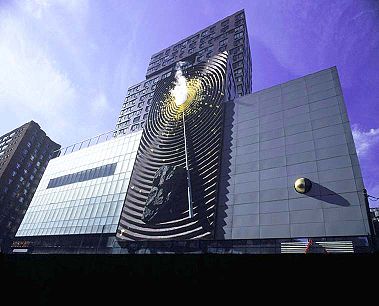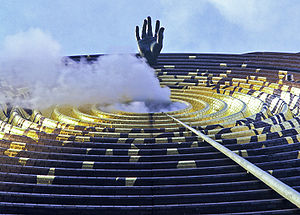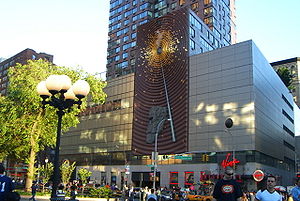
Metronome (Public Artwork)
Encyclopedia

Installation art
Installation art describes an artistic genre of three-dimensional works that are often site-specific and designed to transform the perception of a space. Generally, the term is applied to interior spaces, whereas exterior interventions are often called Land art; however, the boundaries between...
located along the south end of Union Square
Union Square (New York City)
Union Square is a public square in the Manhattan borough of New York City, New York.It is an important and historic intersection, located where Broadway and the former Bowery Road – now Fourth Avenue – came together in the early 19th century; its name celebrates neither the...
in New York City
New York City
New York is the most populous city in the United States and the center of the New York Metropolitan Area, one of the most populous metropolitan areas in the world. New York exerts a significant impact upon global commerce, finance, media, art, fashion, research, technology, education, and...
. The work was commissioned by the Related Companies
The Related Companies
The Related Companies L.P. is a real estate developer, manager and financier. The developer of numerous high-profile projects in New York City and around the United States, Related is best known for its historic 2.8 million-square-foot $1,700,000,000 Time Warner Center on Columbus Circle...
, developers of One Union Square South, with the participation of the Public Art Fund
Public Art Fund
The Public Art Fund is a non-profit organization founded in 1977 by Doris Freedman , a Director of New York City's Department of Cultural Affairs, and the President of the Municipal Art Society. They have organized highly visible artists' projects, new commissions, installations and exhibitions in...
and the Municipal Art Society
Municipal Art Society
The Municipal Art Society of New York, founded in 1893, is a non-profit membership organization that fights for intelligent urban planning, design and preservation through education, dialogue and advocacy in New York City....
. The $4.2 million provided by the developer makes it one of the largest private commissions of public art.
The artwork was created by Kristin Jones and Andrew Ginzel
Jones/Ginzel
Kristin Jones and Andrew Ginzel are a contemporary American artist team. Both Jones and Ginzel pursue independent careers in the arts, but they are best known for their collaborative, large scale public art projects, installations and exhibitions in museums and galleries...
and consists of several sections, including a round circular void from which puffs of white steam are released throughout the day, and a clock made of large orange LED
LEd
LEd is a TeX/LaTeX editing software working under Microsoft Windows. It is a freeware product....
digits.
Installation of Metronome began in February 1999. Its dedication took place on October 26, 1999.
The clock
On the left side of the work is a set of fifteen large LEDLEd
LEd is a TeX/LaTeX editing software working under Microsoft Windows. It is a freeware product....
digits, called "The Passage", which display the time in 24-hour format. The seven leftmost digits show the time in conventional 24-hour format, as hours (2 digits), minutes (2 digits), seconds (2 digits), tenths of a second (1 digit). The seven rightmost digits display the amount of time remaining in a 24-hour day, as tenths of a second (1 digit), seconds (2 digits), minutes (2 digits), hours (2 digits). The center digit represents hundredths of a second, and appears as a blur.
For instance, if the clock reads "195641188180304" (as in the picture at right), it means that time is 19:56 (7:56 PM
12-hour clock
The 12-hour clock is a time conversion convention in which the 24 hours of the day are divided into two periods called ante meridiem and post meridiem...
) and 41.1 seconds, and that there are 04 hours, 03 minutes, and 18.8 seconds remaining in the day.
For a few months in 2005, the clock on Metronome did not give the time of day, but instead counted down the time until the International Olympic Committee
International Olympic Committee
The International Olympic Committee is an international corporation based in Lausanne, Switzerland, created by Pierre de Coubertin on 23 June 1894 with Demetrios Vikelas as its first president...
was to announce the host city of the 2012 Summer Olympics
2012 Summer Olympics
The 2012 Summer Olympic Games, officially known as the "London 2012 Olympic Games", are scheduled to take place in London, England, United Kingdom from 27 July to 12 August 2012...
. New York City ultimately lost its bid to be host city to the 2012 Olympics to London
London
London is the capital city of :England and the :United Kingdom, the largest metropolitan area in the United Kingdom, and the largest urban zone in the European Union by most measures. Located on the River Thames, London has been a major settlement for two millennia, its history going back to its...
.
The clock showed the wrong figures for over a year in 2010/2011 until, in June 2011, the dial-up connection it had previously used to obtain an atomic time reading was updated.
Artists' statement
.jpg)

Jones/Ginzel
Kristin Jones and Andrew Ginzel are a contemporary American artist team. Both Jones and Ginzel pursue independent careers in the arts, but they are best known for their collaborative, large scale public art projects, installations and exhibitions in museums and galleries...
and Andrew Ginzel
Jones/Ginzel
Kristin Jones and Andrew Ginzel are a contemporary American artist team. Both Jones and Ginzel pursue independent careers in the arts, but they are best known for their collaborative, large scale public art projects, installations and exhibitions in museums and galleries...
state that, "Metronome is an investigation into the nature of time. The work references the multiple measures of time that simultaneously inform and confound our consciousness of the moment. The composite work intends to evoke contemplation on the dynamic flux of the city. The elements suggest the instant and infinity, astronomical sequence, geological epoch and ephemerality. Metronome is meant to be integral to the very history, architectural fabric, spirit and vitality of the city.
"The elements that compose Metronome refer to and are very much a part of the place where the work exists: Union Square
Union Square (New York City)
Union Square is a public square in the Manhattan borough of New York City, New York.It is an important and historic intersection, located where Broadway and the former Bowery Road – now Fourth Avenue – came together in the early 19th century; its name celebrates neither the...
in the City of New York
New York City
New York is the most populous city in the United States and the center of the New York Metropolitan Area, one of the most populous metropolitan areas in the world. New York exerts a significant impact upon global commerce, finance, media, art, fashion, research, technology, education, and...
.
"The central element is a brick wall built in concentric circles, creating a wave pattern like ripples on still water after a stone is cast into it, making the wall seem to undulate. Gold leaf accentuates the center of the work, a dark aperture that emanates a constant halo of steam. At noon and midnight the hole erupts with a huge plume of steam that is accompanied by an explosion of sound composed to mark the exact instant and its passage, like a noonday whistle or a public clock that marks the time.
"Counterpoised below on the wall is a massive piece of bedrock, displaying the millennia of geological history. A long thin bronze cone is poised at a diagonal on the rippling brick façade: a time indicator that suggests perspective.
"A large bronze hand poised high on the wall is an accurate enlargement taken from the historical statue of George Washington
George Washington
George Washington was the dominant military and political leader of the new United States of America from 1775 to 1799. He led the American victory over Great Britain in the American Revolutionary War as commander-in-chief of the Continental Army from 1775 to 1783, and presided over the writing of...
in Union Square
Union Square (New York City)
Union Square is a public square in the Manhattan borough of New York City, New York.It is an important and historic intersection, located where Broadway and the former Bowery Road – now Fourth Avenue – came together in the early 19th century; its name celebrates neither the...
Park directly below.
"Left of the vertical brick center, on the glass façade of the building is a horizontal clock with pairs of digits that accurately display the hours, minutes and seconds that have passed since midnight, as well as the time remaining in a 24-hour period. Like an hourglass that contains a specific measure of sand, the digital time piece counts up on the left and down on the right, measuring both the sum and the balance of the day. The center three digits are a frenzy of intangible fractions of seconds, which reveal the pace of life in the city.
"On the right metallic façade is a sphere, half black and half gold, which turns daily in synchrony with the phases of the moon. When the moon reaches fullness, the entire golden face of the orb is revealed.
"Metronome contemplates time: geological, solar, lunar, daily, hourly, and momentarily, revealing the fractions of seconds in the life of a city – and of a human being.
"...New York City
New York City
New York is the most populous city in the United States and the center of the New York Metropolitan Area, one of the most populous metropolitan areas in the world. New York exerts a significant impact upon global commerce, finance, media, art, fashion, research, technology, education, and...
pulses with enormous energy. There is an ever-present sense that an underlying source makes the city a hot spot, active with desire, intellect, pathos. Certain places on earth are geothermally active; Manhattan
Manhattan
Manhattan is the oldest and the most densely populated of the five boroughs of New York City. Located primarily on the island of Manhattan at the mouth of the Hudson River, the boundaries of the borough are identical to those of New York County, an original county of the state of New York...
's streets release vaporous plumes from a plethora of fumaroles. The ephemerality of this steam in the streets suggests the volatility of the place. Metronome poses as a vent for this energy - an oracular center for the public to gauge their momentary presence, their mortality, from which the city can be examined as a vital infrastructure.
"Viewers are confronted and reassured, confused, enlightened and asked to question the moment of their existence in relation to their natural and built environment.
"Ultimately, the work is an ode to mortality and the impossibility of knowing time."
Reception

Herbert Muschamp
Herbert Mitchell Muschamp was an American architecture critic.- Early years :Born in Philadelphia, Muschamp described his childhood home life as follows: “The living room was a secret. A forbidden zone. The new slipcovers were not, in fact, the reason why sitting down there was taboo. That was...
, who described it as "Pretentious... the artists' basic miscalculation was to assume that a large surface called for comparably big forms... It's just some space in a box with a leaky hole in it." The New York Post
New York Post
The New York Post is the 13th-oldest newspaper published in the United States and is generally acknowledged as the oldest to have been published continuously as a daily, although – as is the case with most other papers – its publication has been periodically interrupted by labor actions...
put One Union Square at #2 on its "10 Buildings We Love to Hate" list, calling it "a grotesque modern nightmare." James Gaynor of the New York Observer
New York Observer
The New York Observer is a weekly newspaper first published in New York City on September 22, 1987, by Arthur L. Carter, a very successful former investment banker with publishing interests. The Observer focuses on the city's culture, real estate, the media, politics and the entertainment and...
wrote of Metronome, "Fail so big that no one can do anything about it... New York now has its very own Wailing Wall, a site (and sight) of cultural pilgrimage where the death of esthetics can be contemplated."
In various letters to the editor, the public has written of Metronome: "Well-intentioned, but ultimately flat, corporate art. It is a confounding installation based on a contrived theme ('the impossibility of knowing Time')"; "[a] gigantic waste of time, space, and money [that] seems like a satire on all public monuments"; and "a colossal waste of a facade". However, one respondent felt that Metronome was "a large and very elegant digital hourglass; time 'pours' from the numbers on the right to the left... The other elements are likewise very thoughtful and sophisticated ruminations on time, its passage and the ways in which we mark it."
Further reading
- Morgan, Robert C. “Metronome.” Sculpture. May 2000. pp. 10-12; ill.
- Muschamp, Herbert. “The Ominous Message of a Box on Union Square.” The New York Times. January 2, 2000. pp. 43, 48; ill.
- LeBon,Ian. “Under Metronome.” Metropolis. January 2000. pp. 36, 48; ill.
- Newhall, Edith. “Happening Time and Again.” New York Magazine. October 25, 1999. p. 110; ill.
- Kastner, Jeffrey. “A Giant Timepiece That’s also a Piece about Time.” The New York Times. September 19, 1999. pp. 38, 39; ill.
- Copage, Eric V. “Giant Artwork to Announce Time in Infinite Detail.” The New York Times. June 13, 1999. ill.
- Wines, Suzan. “Oculus & Metronome: two installations for New York City." Domus. April, 1999. p. 34; ill.
- Public Art Fund. "New York Minute (Top 100 Treasures)." Art & Antiques. March 1998. p. 74; ill.
- Clark, Jim. "Passing Time in Union Square." NYArts Magazine. June 1997. p. 52; ill.
- Keenan, Georgina. “Letting Off Steam.” ARTnews. May 1997. p. 36; ill.
- Lazzati , Cristina. “Ventun piani di frivolezza.” L’Espresso. April 24, 1997. p. 147; ill.
- Eccles, Tom. “A timepiece for the millennium and beyond.” Inprocess. Spring 1997. p. 2; ill.
- Vogel, Carol. “An ‘Artwall’ at Union Square.” The New York Times. March 7, 1997. p. C34; ill.

